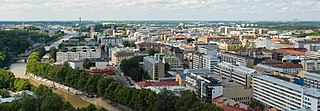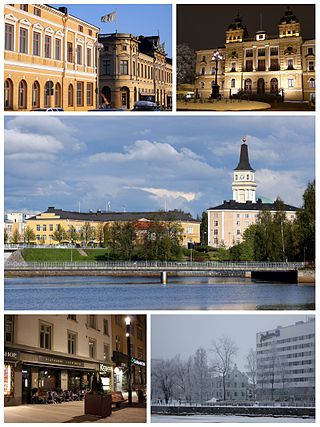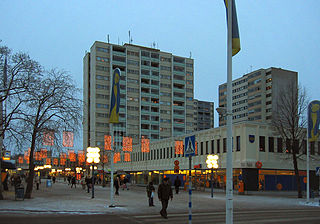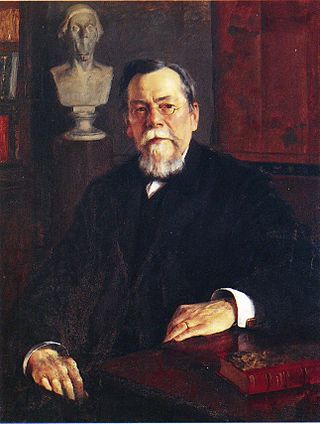
Finland, officially the Republic of Finland, is a Nordic country in Northern Europe. It borders Sweden to the northwest, Norway to the north, and Russia to the east, with the Gulf of Bothnia to the west and the Gulf of Finland to the south, opposite Estonia. Finland covers an area of 338,145 square kilometres (130,559 sq mi) and has a population of 5.6 million. Helsinki is the capital and largest city. The vast majority of the population are ethnic Finns. Finnish and Swedish are the official languages, with Swedish being the native language of 5.2% of the population. Finland's climate varies from humid continental in the south to boreal in the north. The land cover is predominantly boreal forest biome, with more than 180,000 recorded lakes.

Georg Henrik von Wright was a Finnish philosopher.

Helsinki is the capital, largest and most populous city in Finland. Located on the shore of the Gulf of Finland, it is the seat of the Uusimaa region in southern Finland and has a population of 673,011. The city's urban area has a population of 1,268,296, making it by far the most populous urban area in Finland and the country's most important centre for politics, education, finance, culture and research. Helsinki is located 80 kilometres (50 mi) north of Tallinn, Estonia, 400 km (250 mi) east of Stockholm, Sweden, and 300 km (190 mi) west of Saint Petersburg, Russia. It has close historical links with these three cities.

The Uralic languages form a language family of 38 languages spoken natively by approximately 25 million people, predominantly in Europe and northern Asia. The Uralic languages with the most native speakers are Hungarian, Finnish, and Estonian. Other significant languages with fewer speakers are Erzya, Moksha, Mari, Udmurt, Northern Sámi, Komi, Karelian and the Samoyedic languages, all of which are spoken in northern regions of Scandinavia and parts of the Russian Federation.

Turku is a city and former capital on the southwestern coast of Finland at the mouth of the River Aura, in the region of Southwest Finland (Varsinais-Suomi) and the former Turku and Pori Province. The region was originally called Suomi (Finland), which later became the name of the whole country. The population of Turku is 201,085 making it the sixth largest city in Finland. The Turku region has a population of 345,522, making it the third largest urban area in Finland after the Helsinki and Tampere regions. The city is officially bilingual, with 5.5 per cent of the population having Swedish as their mother tongue.

Oulu is a city, municipality and a seaside resort of about 210,000 inhabitants in the region of North Ostrobothnia, Finland. It is the most populous city in northern Finland and the fifth most populous in the country after: Helsinki, Espoo, Tampere and Vantaa, and the fourth largest urban area in the country after Helsinki, Tampere and Turku. Oulu's neighbouring municipalities are: Hailuoto, Ii, Kempele, Liminka, Lumijoki, Muhos, Pudasjärvi, Tyrnävä and Utajärvi.

The University of Helsinki is a public research university located in Helsinki, Finland, since 1829, but founded in the city of Turku in 1640 as the Royal Academy of Åbo, at that time part of the Swedish Empire. It is the oldest and largest university in Finland with the widest range of disciplines available. In 2020, around 31,600 students were enrolled in the degree programs of the university spread across 11 faculties and 11 research institutes.

Kotka is a city in the southern part of the Kymenlaakso province on the Gulf of Finland. Kotka is a major port and industrial city and also a diverse school and cultural city, which was formerly part of the old Kymi parish; later, Kymi with the Haapasaari island and Karhula, the latter of which once separate from Kymi as the market town, were incorporated into Kotka. The neighboring municipalities of Kotka are Hamina, Kouvola and Pyhtää. Kotka belongs to the Kotka-Hamina subdivision, and with Kouvola, Kotka is one of the capital center of the Kymenlaakso region. It is the 19th largest city in terms of population as a single city, but the 12th largest city of Finland in terms of population as an urban area.

Pelit ("Games") is a Finnish video games magazine published in Helsinki, Finland.

Kerava is a town and municipality within the Uusimaa region of Finland. The municipalities of Vantaa, Sipoo and Tuusula are adjacent to Kerava, which is part of the Helsinki metropolitan area.
Niko Nirvi, pen name Nnirvi, is a long-term major icon in the Finnish gaming world. He is well known for writing computer game reviews since the 1980s in MikroBitti, C=Lehti and the computer game yearbooks that were predecessors of the Pelit magazine. He has worked for the latter since its founding in 1992, and holds a column in addition to making reviews and other reports.

Julius Leopold Fredrik Krohn was a Finnish folk poetry researcher, professor of Finnish literature, poet, hymn writer, translator and journalist. He was born in Viipuri and was of Baltic German origin. Krohn worked as a lecturer on Finnish language in Helsinki University from the year 1875 and as a supernumerary professor from 1885. He was one of the most notable researchers into Finnish folk poetry in the 19th century. His native language was German.

Lauri Pekka Hakulinen was a professor of Finnish at the University of Helsinki and the director of the Finnish Dictionary Fund (Sanakirjasäätiö).

Karl August Engelbrekt Ahlqvist, who wrote as A. Oksanen, was a Finnish professor, poet, scholar of the Finno-Ugric languages, author, and literary critic. He is best remembered as the sharpest critic of writer Aleksis Kivi, who later rose to the position of the national author of Finland.

Benno Alexander "Santeri" Levas was a Finnish writer and photographer, best known for his books on the composer Jean Sibelius.

Yrjö Aulis Uramo Blomstedt was a Finnish architect and professor of architecture at the Helsinki University of Technology. He was a renowned modernist architect and architectural theoretician in the decades following the Second World War. Blomstedt was born into an architect family: his father Yrjö Blomstedt was an architect known for his National Romantic Jugend architecture, while his older brother Pauli E. Blomstedt was, until his premature death at the age of 35, a pioneering early modernist architect. His other brother, Jussi Jalas, was a composer. Blomstedt was married to Heidi Blomstedt, the daughter of the composer Jean Sibelius. They had two children, the artist Juhana Blomstedt and the architect Severi Blomstedt.
Finnish national symbols are natural symbols or Finnish national works and prominent figures that are commonly associated with Finland. The most recognized national symbols include the flag of Finland and the lion featured on the Finnish coat of arms.
Arabs in Finland are residents and citizens of Finland who speak the Arabic language.

Pekka Heikki Tapani Gronow is a Finnish ethnomusicologist and historian of the recording industry. He studied at Wesleyan University with David P. McAllester and Robert E. Brown and at the University of Helsinki and received his PhD from the University of Tampere. He was the head of the record library at Yleisradio 1989–2006 and an archiving specialist 2007–2008. Gronow became known in the 1960s for his radio programs on jazz and blues. In 1966 he founded with M. A. Numminen Eteenpäin, a record company which issued Numminen's works and other underground artists.

Vietti Brynolf Nykänen was a Finnish architect, writer and politician.

















